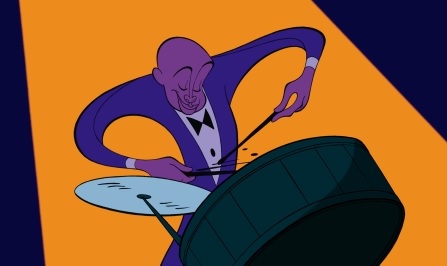
|
This page is a stub. You can help the Fantasia Wiki by expanding it. |
| Rhapsody in Blue | |

number=Three | |
| Name | Rhapsody in Blue |
| Segment Number | {{{number}}} |
| Runtime | 12:30 |
| Music | Rhapsody in Blue (used by permission) |
| Composer | George Gershwin |
| Director(s) | Eric Goldberg |
| Story Development/Research | {{{story}}} |
| Art Direction | Susan Goldberg |
| Background Painting | Natalie Franscioni-Karp |
| Animation Supervisor(s) | {{{animationsupe}}} |
| Animation | Tim Allen James Baker |
| Special Camera Effects | {{{specialeffects}}} |
| Previous Segment | Pines of Rome |
| Next Segment | Piano Concerto No. 2 |
| Gallery | {{{gallery}}} |
Rhapsody in Blue is the third and longest segment of Fantasia 2000, based on Ferde Grofé's orchestration of the piece of the same name.
Inspired by the work of caricaturist Al Hirschfeld (who himself contributed to the segment's production as a consultant), the segment tells a story interwoven around the lives of four different people in Depression-era New York City.
Overview[]
Introduction[]
After a brief performance piece by pianist Ralph Grierson, Quincy Jones explains to the audience that they would now take them to the streets of New York City for a piece inspired by a couple of his favorite artists. Firstly was the illustrator, Al Hirschfeld, who spent most of the 20th century doing caricatures of celebrities and broadway stars. Secondly was composer/songwriter George Gershwin, who was known to take inspiration for his jazz pieces from the streets. Jones then introduces Grierson, who features on piano in the next segment, and explains that the next segment all starts with "a single, slinky note on the clarinet and a simple line on a piece of paper." Gershwin's very own Rhapsody in Blue.
Synopsis[]
Characters[]
- Duke
- Joe
- Rachel
- John
Credits[]
- Musical score: Rhapsody in Blue by George Gershwin
- Performed by the Philharmonia Orchestra
- Director: Eric Goldberg
- Writer: Eric Goldberg
- Animator: Eric Goldberg
- Art direction: Susan McKinsey Goldberg
- Design consultant: Al Hirschfeld
- Production manager: Loni Beckner-Black
- Artistic coordinator: Dan Hansen
- Assistant artistic coordinator: David Blum
- Featured pianist: Ralph Grierson
- Conductor: Bruce Broughton
Film version[]
- Composer: George Gershwin
- Conductor and Supervisor: Bruce Broughton
- Piano: Ralph Grierson
- Direction and Story: Eric Goldberg
- Art Director: Susan McKinsey Goldberg
- Design Consultant: Al Hirschfeld
- Co-Producer: Patricia Hicks
- Layout: Rasoul Azadani
- Backgrounds: Natalie Franscioni-Karp
- Artistic Coordinator: Dan Hansen
- Assistant Artistic Coordinator: David Blum
- Visual Effects: Mauro Maressa
- Clean-Up: Emily Jiuliano, Vera Lanpher-Pacheco
- Production Manager: Loni Beckner-Black
Trivia[]
- Gershwin himself makes a cameo during the segment.
- Like The Sorcerer's Apprentice, the piece the segment is set around was composed by a different orchestra from the featured orchestra. In this case, the Philharmonia Orchestra instead of the Chicago Symphony Orchestra.
- This is the only segment from 2000 to have entirely different compositions of the piece between its film and soundtrack versions. Although both recordings have the same runtime, the one used in the film was conducted by Bruce Broughton, while the soundtrack version was conducted by James Levine. The Philharmonia Orchestra was involved in both recordings.